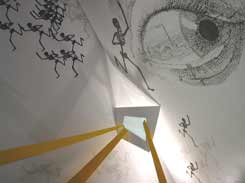|
The
"EXTRAVAGANZA"
began in November 2001 with the
installation of a storefront window
facing 42nd street and an
art exhibit inside (1), and on January
24th 2002, a live
video and performance(2).
1) The art exhibit
featured
applicants willy mal and Benton-C Bainbridge,
among others. Over 100 visitors eventually passed through
the exhibt from 8 PM to midnight. Many hundred walked by outside,
and visitors included a large number of these passersby. Responses
were vigorous. Precise spotlighting on non-video works made
all
video installations easy to see.
Bainbridge's "blind
heat" installation included a bed. The bed's sheets served to
reflect projected video from above, and a subwoffer underneath
the
bed broadcast the video soundtrack. His piece considered
the idea
of exciting physical passions while deflecting the
direct viewer-attention.
Visitors sat on the bed, felt the
woofer kick and touched the video-flickered
sheets.
The
"exoptitron"
playing "exoptic fields," by mal,
includes moveable magnifying lenses
that invite manipulation
and focus. Visitors responded by moving
the lenses. Banners
in the installation made the piece's central
intention
explicit: to consider deflection as a media objective
as
opposed to "attraction."
Jean-Philippe Baert
also
exhibited a video version of his TV "fossil" made by
exposing photo paper to television screens during news broadcasts.
A video loop of one such piece played on a 5" screen.
Other work included
Steven Katz' 15-foot sculpture, "peer"; Bob
Gill's
design for the "exoptic fields" video box,
installed by willy mal;
a storefront window by Nathalie
Adamidi and willy mal; a
video loop of Benton Bainbridge
and Naval Cassidy speaking on a
Canadian TV program
describing "deflective" media and the "blind
eye projects."
2) On 24 January 2002, the performances
started about 8:30pm
before an audience of 65 people.
Naval Cassidy's performance,
the first, followed his
proposed design and included an assistant.
Cassidy
communicated detailed instructions to the audience via printed-text
on paper strips drawn under a camera and displayed on a large TV
monitor. These messages were mixed with other images produced and
captured live. The printed instructions prepared the audience
for
a series of "demonstrations" on "looking" and "looking
away." These
involved objects viewed by camera and direct, as
well as objects
thrown into the audience. The assistant used
a tiny hand-held camera
to his eye, for instance, to
illustrate the procedure. This image
appeared with the image
of a clock used as the map of for eye-directions
in one of
the demonstrations. The audience could see Cassidy monitor
his actions on a second screen above his long table of props.
Abigail Child's "Best of Both Worlds" was a comparatively
spare counterpoint to Naval's calculated barrage. She and her
assistant
dressed in white smocks and black crotch-harnessed
belts, miming
lab technicians or electricians, positioned -
and repositioned -
themselves both casually and deliberately
to reflect the light of
TV monitors and to catch the
projection of a film that was reflected
off a Mylar wall onto
a white screen. Two TV monitors, in sync,
were tuned manually
by Child, and assistant Fernanda Affonseca,
to broadcast
programming. These were often left tuned to distorted
and
rolling images but would surface occasionally into a realizable
broadcast image. A third much larger screen played back a crisp
video of city winter skyscapes, of roofs, smoking furnace stacks,
rhymed with clouds rolling in real time across the frame. It
included
sound and had both a passive and faintly sinister
overtone [the
storm approaches] though its references were
largely to the quotidian
and diurnal exterior world. The film
projector ran a sex scene from
a 1970s pornographic film in
which a man describes being penetrated
by a woman wearing a
"strap-on" dildo. Near the end of the piece
we hear him
state: "...It was like having the best of both worlds..."
A
third musical source played a minimal rapid-beat of synthesized
music. The issues raised in the performance, inspired by the Exoptic
Theme, include: the narrative force of the body; the body as
obstacle
and desire; ideas of INTERFERENCE; the competing
textures of the
mediated visual world as techno fuzz, window,
and/or deflected projection
[the reflected screen]; the
contrast of attention between the exterior
and the interior,
between the 'real' and the mediated, between what
can be
'tuned' and what continues despite human ' interference.'
All
this with a crackling ironic humor bubbling underneath.
Fritz Donnelly's "Very Special Performance Tonight Only"
opened with a video of himself as a TV language instructor giving
a series of lessons in a made-up language that sounded like
Italian
or Russian. He then appears, in person, as the
language instructor
and gives a lesson, inviting an audience
member to participate.
He invites the audience to repeat
after him, and has many speaking
this new language. In effect
he "re-edits" the video tape in-vivo,
on stage. Then he
leaves stage to return as another character speaking
a
different made-up language and proceeds to rap in that Chinese-sounding
language, pushing the "edit" to distortion.
Benton-C's "blind heat: stasis & storm mix" positioned a
large TV monitor on the floor, about center-stage, facing away from
the audience to a Mylar wall. Benton-C launched a live re-mix
of
"blind heat" that included music that played on the TV,
reflected
in the wall or seen from the edges by the audience.
Benton-C sat
at a table on stage before his laptop and other
equipment with glowing
dials. Anita Durst appeared in a
bride's white dress, walked behind
the TV to position herself
to crawl and drag herself slowly over
the monitor. Her
dress's folds reflected its pulsing light. For
more than ten
minutes she pulled herself directly toward the back
wall,
over the top of the set. While prone, propped on her elbows
with her thighs still resting on the TV-top, she proceeded to smoke
in this position before pulling herself completely off the set,
rolling to the side and standing. She made several walking turns
then left the stage.
|
 |

